Honor Award
Living Scaffold: Reimagining the
Continental Bridge
Christina Sohn, Student ASLA and James W.T. Yan, Student ASLA, The University of Texas at Austin
Faculty Advisor: Jason Sowell
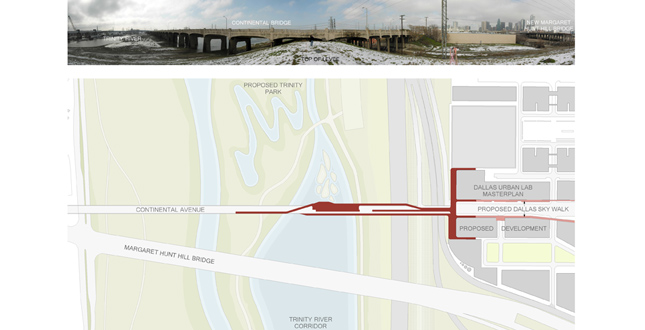 Close Me!
Close Me!Context Plan. Our design benefits from the proposed commercial and residential development that the new infrastructure and park system establish. Tying into this edge and the proposed skywalk, our project sets up a promenade between city and river where pedestrians and bicyclists can access the park path system.
Download Hi-Res ImagePhoto: Nick Simonite
Photo 1 of 16
 Close Me!
Close Me!Programmatic Analysis. Top: Zones and Transition. Bottom: Nodes and Circulation.
Download Hi-Res ImagePhoto: Nick Simonite
Photo 2 of 16
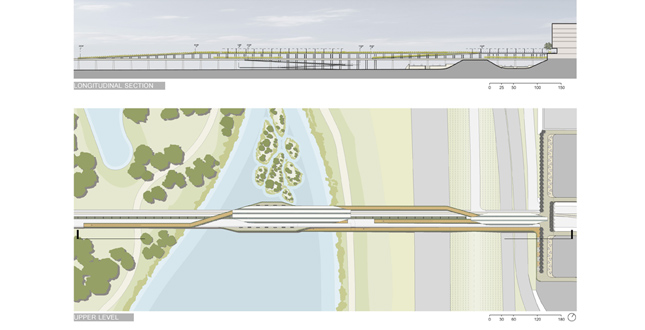 Close Me!
Close Me!Upper Level. New highways and a levee form a heavy physical and visual barrier that severs possible connections between downtown Dallas and the Trinity River. This project highlights the importance of landscape architecture in creating this connection, and in navigating a delineation of form and space to address innate tensions between city and river.
Download Hi-Res ImagePhoto: Nick Simonite
Photo 3 of 16
 Close Me!
Close Me!Site Plan. The transition from the top to bottom levels parallels a transition in program from more active and urban recreational functions to more passive activities that engage the river ecology. This multi-layered experience is visible through the game courts on the top level, fishing platform on the bridge level, and bottom level bird-watching platform.
Download Hi-Res ImagePhoto: Nick Simonite
Photo 4 of 16
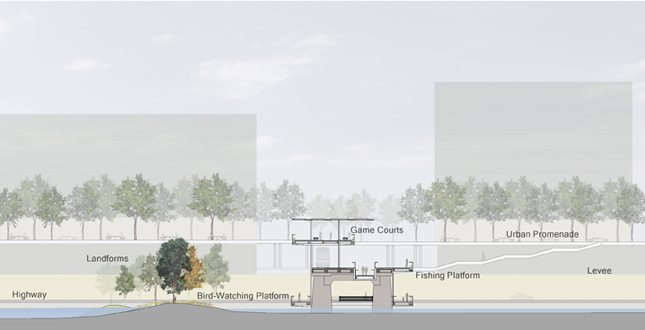 Close Me!
Close Me!Transverse Section. The lower level platform looks to the design’s new landforms that create an opportunity for bird watching. The three bridge platforms allow visitors to physically and visually engage with the river.
Download Hi-Res ImagePhoto: Nick Simonite
Photo 5 of 16
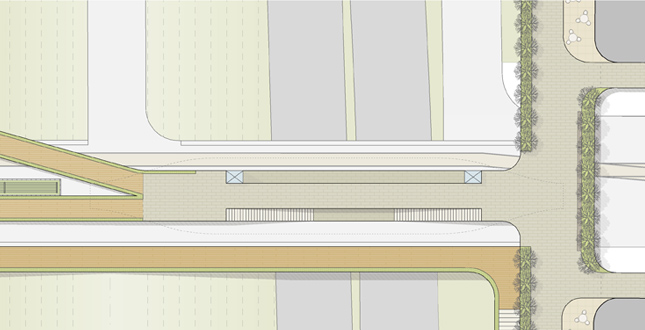 Close Me!
Close Me!Zoomed in Site Plan. To facilitate movement between riverbanks, a DART rail line that previously stopped at the urban edge is extended across the bridge to connect the separated communities by rail. The rail stop is near a stairway and elevator that facilitates commuter engagement with the multi-level promenade.
Download Hi-Res ImagePhoto: Nick Simonite
Photo 6 of 16
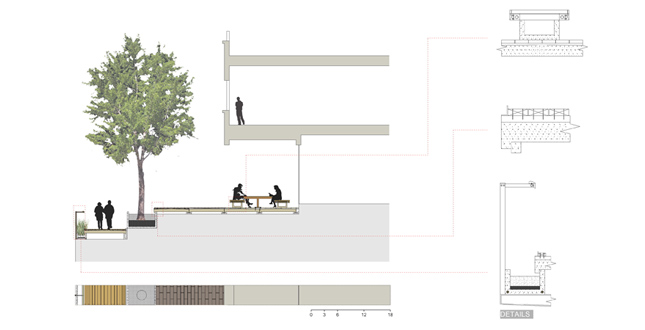 Close Me!
Close Me!Detail Section. This section shows the design’s connection with the city edge and proposed commercial development. The bench and handrail details describe the integrated lighting system.
Download Hi-Res ImagePhoto: Nick Simonite
Photo 7 of 16
 Close Me!
Close Me!Zoomed in Site Plan. The extensive path system of the design stretches from the proposed urban development at an above-bridge level, ramps down to the bridge, and at one point cuts through the bridge, piercing its heavy structure to ramp down further and connect with the park’s greenway and river below.
Download Hi-Res ImagePhoto: Nick Simonite
Photo 8 of 16
 Close Me!
Close Me!Detail Section. Paths undulate between three platform levels. Each level contextualizes a corresponding vista—city, bridge, and park activity. Path structure depends on steel beams and columns that attach to the existing bridge. A vertical frame supports drought tolerant vines to shade adjacent paths.
Download Hi-Res ImagePhoto: Nick Simonite
Photo 9 of 16
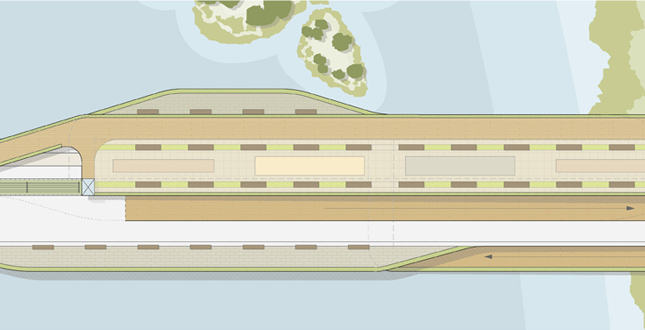 Close Me!
Close Me!Zoomed in Site Plan. The upper platform houses the game courts and is long and linear; serving as an extension of urban recreational activity from downtown out into the river corridor. From this elevated platform, visitors can view kayaking, rafting, and other aquatic activities below.
Download Hi-Res ImagePhoto: Nick Simonite
Photo 10 of 16
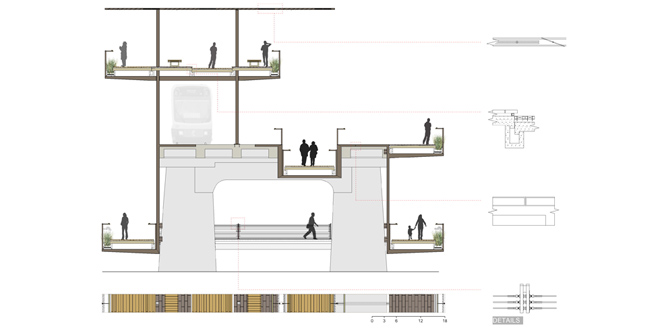 Close Me!
Close Me!Detail Section. The upper level features recessed courts for shuffleboard, bocce, and horseshoes. Benches surrounding the lanes provide seating for spectators or those viewing events in the park below. The shade structure incorporates photovoltaic panels that rotate to maximize sun exposure.
Download Hi-Res ImagePhoto: Nick Simonite
Photo 11 of 16
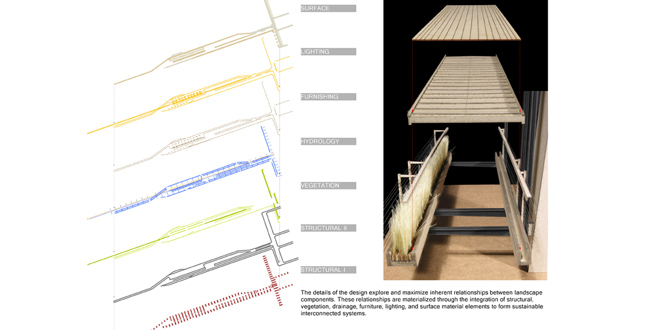 Close Me!
Close Me!Component Integration & Interdependence. The details of the design explore and maximize inherent relationships between landscape components. These relationships are materialized through the integration of structural, vegetation, drainage, furniture, lighting, and surface material elements to form sustainable interconnected systems.
Download Hi-Res ImagePhoto: Nick Simonite
Photo 12 of 16
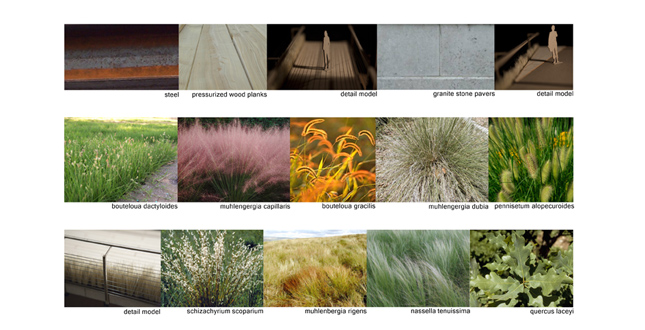 Close Me!
Close Me!Materials & Plant Palette. Simple materials are utilized that begin to register rhythm and threshold. Drought adapted grasses, vine and tree species are planted in linear gradients to reflect seasonal hydrologic fluctuations and maximize runoff filtration.
Download Hi-Res ImagePhoto: Nick Simonite
Photo 13 of 16
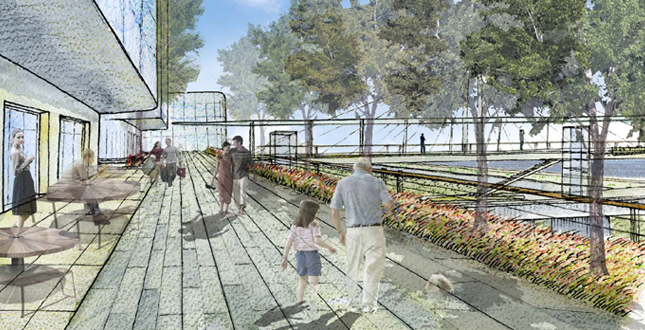 Close Me!
Close Me!View from Promenade Looking South. The design anticipates the proposed businesses that will front the river. Their facades envelop the visitor within structure and trees. From this belvedere the pedestrian can view the bridge, and the layered profile of the design’s ramping path system.
Download Hi-Res ImagePhoto: Nick Simonite
Photo 14 of 16
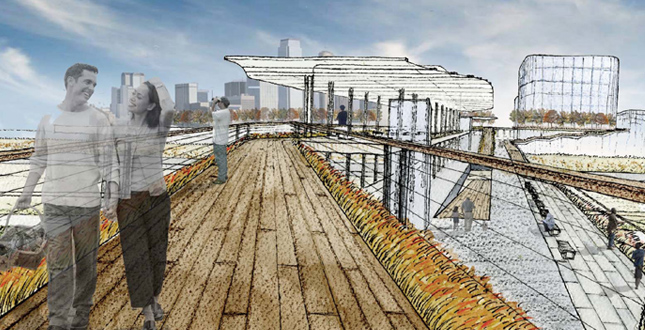 Close Me!
Close Me!View from Upper Level Looking East. At each level, the path thickens at some point to create a platform, and a place to pause. From this vantage point, the visitor visually connects with the city, and can see the upper level game lanes, as well as the bridge level fishing area.
Download Hi-Res ImagePhoto: Nick Simonite
Photo 15 of 16
 Close Me!
Close Me!View from Lower Level Looking West. The lower level allows the visitor to more intimately engage with the river and its habitat both physically through proximity to the water as well as programmatically through the establishment of a bird watching platform.
Download Hi-Res ImagePhoto: Nick Simonite
Photo 16 of 16
Project Statement
Our project transforms the Continental Bridge into a dynamic connection between the Dallas downtown urban edge and new Trinity River Park. We reimagine the bridge as a layered experience that accentuates contextual datums intrinsic to the site. The project creates a living scaffold which synthesizes the energy and vivacity of the city with the rhythms, cycles, and seasons of the Trinity River.
Project Narrative
The construction of two Calatrava bridges in Dallas, Texas has led to the reprogramming of the section of Continental Avenue that spans the Trinity River Corridor. These efforts are coupled with the reengineering of the Trinity River as a series of flood control wetlands, lakes, and recreational spaces. New highways and a levee form a heavy physical and visual barrier that severs possible connections between downtown Dallas, and the Trinity River. This project highlights the importance of landscape architecture in forming this connection, and in navigating the delineation of form and space to address innate environmental tensions. The bridge becomes a comprehensive mechanism to reconcile disparate contextual parts.
The Dallas Edge
The city of Dallas is currently undertaking a large urban development effort with the Trinity River Corridor Project. The city plans to reclaim the river as a valued natural resource, to create an extensive greenway for recreational activity, and to develop neighborhood and business areas adjacent to the river. The Continental Avenue Bridge represents one of the few opportunities for visitors to access the new park space. Our design benefits from the proposed commercial and residential development that the new infrastructure and park system establish. Tying into this edge, and the proposed Dallas Skywalk, the project sets up a promenade between city and river, where pedestrians and bicyclists can access the park path system.
Movement and Program
Our project organizes the movement of pedestrians, bicyclists, cars, trains, runoff and sunlight, and considers the ways in which these components interact. Removal of automobiles from the bridge recalibrates the space to create a pedestrian oriented experience. To facilitate movement between riverbanks, a DART rail line is extended across the bridge to connect the separated communities. The path system stretches from the proposed urban development at an above-bridge level, ramps down to the bridge, and connects with the park’s greenway. This change in path elevation, and the corresponding platforms, registers a gradient of city to park activity.
The design sets up the layered framework, but the user defines the path, experience, and tempo. Each level contextualizes a corresponding vista: city, bridge, and park. At each level, path transitions to platform to house the following programs: upper level – game boards and overlook, bridge level – fishing, lower level – bird watching, and park access. The upper level features recessed courts for shuffleboard, bocce, and horseshoes. Benches surrounding the lanes provide seating for spectators or those viewing events in the park below (Page 10). As the user moves between levels the transition parallels a gradient in program from more active and urban to activities that engage the river ecology (Page 04).
Designed Collection
The details of the design study methods of collection, look at relationships between components, and reinforce the design’s overarching goal to form connections (Page 12). A water collection system begins with the path framework. The paths are supported by a modulated concrete beam, sleeper, and girder system that slopes to direct drainage; it collects water to support vegetation along the edges while excess water is stored in a cistern for reuse. Shade structures, positioned to partially cover the upper level platform and the train stop incorporate photovoltaic solar panels that rotate to maximize sun exposure time (Page 11). This energy is redirected to supplement the electricity needed to support the project’s lighting system (Pages 07 & 11). While structural, these energy-collecting components provide a feedback loop that supports the design and establishes a more sustainable footprint.
Dynamic Connections
The Continental Bridge moves through distinct elements and spaces. By repurposing the body of the bridge, our design builds a new dialogue between currently disparate elements. The landscape becomes structural and elevated, yet grounded in the human experience as visitors engage the river and its processes. The structure becomes a living scaffold; providing the armature for urban activity, energy, and vivacity to meld with the unique rhythms, cycles, and seasons of the Trinity River.
Additional Project Credits





